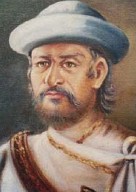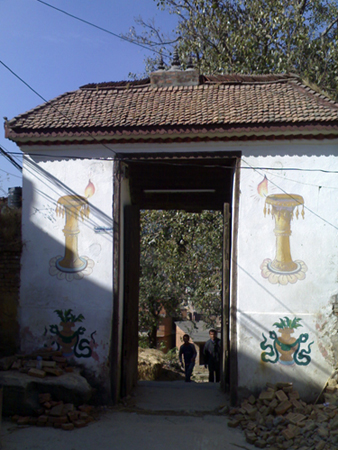|
Shreepali
The Shreepali Basnet are originally from the Saipal, Far West Region who got their prominence in Gorkha district of Nepal. They mainly worship 'Masto' as their 'Kulayan' but saipali from Gorkha has changed their worship to "Sishakoti Mahadev", "Veerabhadra", "Mahakali" as their Kul Deuta and Aradhe Devi " Dakshinkali" as Istha deuta in style of Kunwar Rana. They became very powerful during the unification of Nepal and remained so until the emergence of Jung Bahadur Kunwar or later known as Jang Bahadur Rana. The King's men It is known that during the reign of King Prithivi Narayan Shah the Shreepali Basnyats of Gorkha were the leading military force. They were either highly ranked officers in the army or key figures in the king's court. King Prithvi Narayan Shah formed an alliance between the Basnyat and Pandey families of Gorkha in his quest for the unification of Nepal. Shivaram Singh Basnyat, the commander of Gorkhali forces belonged to Shreepali Basnyat clan. He was son of ... [...More Info...] [...Related Items...] OR: [Wikipedia] [Google] [Baidu] |
Basnyat
Basnyat/Basnet family or Basnyat/Basnet dynasty ( ne, बस्न्यात वंश/बस्न्यात काजी खलक) was a Khas-Chhetri and a warlord clan family involved in the politics and administration of the Gorkha Kingdom and Kingdom of Nepal. This family got entry into Thar Ghar aristocracy group of Gorkha at the time of King Prithvi Narayan Shah. It was one of the four noble families to be involved in active politics of Nepal together with Shah dynasty, Pande family and Thapa dynasty before the rise of Rana dynasty. This family is descended from Shivaram Singh Basnyat, the commander of Gorkhali forces and a member of Shreepali Basnyat clan of Gorkha. This family was maritally linked to ''Kala'' (Black) Pande section of Pande dynasty through Chitravati Pande who married Kaji Kehar Singh Basnyat. This family was the last Kshatriya (Chhetri) political family to be wiped out from the central power by Jung Bahadur Rana of Kunwar family during the Bhandar ... [...More Info...] [...Related Items...] OR: [Wikipedia] [Google] [Baidu] |
Shivaram Singh Basnyat
Shivaram Singh Basnyat ( ne, शिवराम सिंह बस्न्यात) was the military commander of Gorkha. After the conquest of Naldum area by the Gorkhalis, he along with Commander Bir Bhadra Thapa conquered Sanga, Panauti, Sankhu and adjacent areas. They received fierce resistance from the Kantipur Kingdom at Sangachok. He died in the defensive battle of Sanga Chowk during Unification of Nepal on 1803 B.S. Personal life He was born to Jayaram Singh Basnyat in the clan of Shreepali among Basnyats. He had four sons - Naahar Singh Basnyat, Kehar Singh Basnyat Kehar Singh Basnyat ( ne, केहरसिंह बस्न्यात) or Kehar Singh Basnet was a Nepalese military commander and warhero who led down his life in the Unification battles of Nepal. He was born in the illustrious clan of Shr ..., Abhiman Singh Basnet and Dhokal Singh Basnyat. His third son went on to become Supreme Commander of the Nepalese Army and Chief Minister ( Mulkazi) i ... [...More Info...] [...Related Items...] OR: [Wikipedia] [Google] [Baidu] |
Basnet
Basnet/Basnyat ( ne, बस्नेत/बस्न्यात) is a surname of Khasas of Nepal and India. It is found among Jharra Chhetri community. There are five different branches of Basnets in Nepal: *The Shreepali (Sripali) Jumli Basnets of Jumla bharadwaja later Gorkha. *The Khaptari (Khaptadi Basnyat) King of Khaptad Raghuvanshi Kshatriya Kaushik gotriya *The Lamichhane Lamichhane ( ne, लामिछाने) is a surname found in Nepal. Some notable Lamichhane include: * Gopal Chandra Lamichhane (b. 1974) *Jiba Lamichhane, Nepalese businessman * Khagendra Lamichhane, Nepalese actor, writer and director *Rabi L ...; Garga gotriya Basnets Notable people with surname Basnet References {{Chhetri communities Surnames of Nepalese origin Nepali-language surnames ... [...More Info...] [...Related Items...] OR: [Wikipedia] [Google] [Baidu] |
Abhiman Singh Basnyat
Abhiman Singh Basnet/Basnyat ( ne, अभिमान सिंह बस्न्यात) was first Commander-in-Chief of Unified Nepal."Regmi Research Series" Author:Mahesh Chandra Regmi Abhiman Singh became the first Commander in Chief of a United Nepal after General Kalu Pande died during his second attempt to capture Kirtipur. He had participated in invasion of Makawanpur during Unification of Nepal. He commanded battles in Sino-Nepalese War as subordinate commander under Chautariya Shree Krishna Shah. He commanded and annexed Tanahun Kingdom into unified Nepal. In 1794 AD, King Rana Bahadur Shah dissolved government to overthrow Bahadur Shah of Nepal. Kirtiman was appointed as Chief (''Mul'') Kaji among the four Kajis succeeding Abhiman Singh. In 1857 B.S., he was sent to settle the area of the Kirata regional areas comprising; Pallo Kirant Limbuwan , Majh Kirant Khambuwan and Wallo Kirant , then called Kaala Banzaar. It was a great injustice to him to being sent ... [...More Info...] [...Related Items...] OR: [Wikipedia] [Google] [Baidu] |
Kehar Singh Basnyat
Kehar Singh Basnyat ( ne, केहरसिंह बस्न्यात) or Kehar Singh Basnet was a Nepalese military commander and warhero who led down his life in the Unification battles of Nepal. He was born in the illustrious clan of Shreepali Basnyats - member of Kshettriya (warrior) class. Family He was born as second son of General ''Senapati Badabir'' Shivaram Singh Basnyat. He had three brothers; Naahar Singh Basnyat, Abhiman Singh Basnyat and Dhokal Singh Basnyat. He had three sons - Kirtiman Singh Basnyat, Bakhtawar Singh Basnyat and Jahar Singh Basnyat. King Prithvi Narayan Shah formed an alliance with Basnyat family and Pande family of Gorkha in his quest for the unification of Nepal. As per his Divya Upadesh, King Prithvi Narayan is known to have arranged the marriage between Kaji Kehar Singh and Chitra Devi, the daughter of Kaji of Gorkha Kalu Pande. His father Shivaram Singh was addressed as Senapati Badabir (Brave Chief of the Army) in all the documen ... [...More Info...] [...Related Items...] OR: [Wikipedia] [Google] [Baidu] |
Mahakali
Mahakali () is the Hindu goddess of time and death in the goddess-centric tradition of Shaktism. Similar to Kali, Mahakali is a fierce goddess associated with universal power, time, life, death, and both rebirth and liberation. She is the consort of Bhairava, the god of consciousness, the basis of reality and existence. Mahakali, in Sanskrit, is etymologically the feminised variant of Mahakala, or ''Great Time'' (which is interpreted also as ''Death''), an epithet of the deities Narasimha and Shiva in Hinduism. Meaning Mahakali's origin is contained in various Puranic and Tantric Hindu Scriptures ( Shastras). In the texts of Shaktism, she is variously portrayed as the Adi-Shakti, the Primeval Force of the Universe, identical with the Ultimate Reality, or Brahman. She is also known as the (female) Prakriti or World as opposed to the (male) Purusha or Consciousness, or as one of three manifestations of Mahadevi (The Great Goddess) that represent the three Gunas or att ... [...More Info...] [...Related Items...] OR: [Wikipedia] [Google] [Baidu] |
Bakhtawar Singh Basnyat
Bakhtawar Singh Basnyat ( ne, बख्तावर सिँह बस्न्यात) was Mulkazi (Chief Kazi) of Nepal. Mulkazi Kirtiman Singh Basnyat who was backed by Queen Regent Subarna Prabha Devi, was secretly assassinated on 28 September 1801, by the supporters of Raj Rajeshwari Devi. Damodar Pande was also blamed for the murder. During the investigation, many were punished without any evidence and he was given the position and title held by his brother Kirtiman Singh for a brief period. During his tenure as the ''mul kaji'', on 28 October 1801, a Treaty of Commerce and Alliance was finally signed between Nepal and East India Company. This led to the establishment of the first British Resident A resident minister, or resident for short, is a government official required to take up permanent residence in another country. A representative of his government, he officially has diplomatic functions which are often seen as a form of ind ..., Captain William O. Kn ... [...More Info...] [...Related Items...] OR: [Wikipedia] [Google] [Baidu] |
Kathmandu
, pushpin_map = Nepal Bagmati Province#Nepal#Asia , coordinates = , subdivision_type = Country , subdivision_name = , subdivision_type1 = Provinces of Nepal, Province , subdivision_name1 = Bagmati Province , subdivision_type2 = List of districts of Nepal, District , subdivision_name2 = Kathmandu District, Kathmandu , established_title = , founder = Manjushri , parts_type = No. of Ward (electoral subdivision), Wards , parts = 32 , seat_type = , seat = , government_footnotes = , government_type = Mayor–council government , governing_body = Kathmandu Metropolitan Government, , leader_title = Mayor of Kathmandu, Mayor , leader_name = Balendra Shah (Independent politician, Ind.) , leader_title1 = Deputy mayor , leader_name1 = Su ... [...More Info...] [...Related Items...] OR: [Wikipedia] [Google] [Baidu] |
Tibet
Tibet (; ''Böd''; ) is a region in East Asia, covering much of the Tibetan Plateau and spanning about . It is the traditional homeland of the Tibetan people. Also resident on the plateau are some other ethnic groups such as Monpa people, Monpa, Tamang people, Tamang, Qiang people, Qiang, Sherpa people, Sherpa and Lhoba peoples and now also considerable numbers of Han Chinese and Hui people, Hui settlers. Since Annexation of Tibet by the People's Republic of China, 1951, the entire plateau has been under the administration of the People's Republic of China, a major portion in the Tibet Autonomous Region, and other portions in the Qinghai and Sichuan provinces. Tibet is the highest region on Earth, with an average elevation of . Located in the Himalayas, the highest elevation in Tibet is Mount Everest, Earth's highest mountain, rising 8,848.86 m (29,032 ft) above sea level. The Tibetan Empire emerged in the 7th century. At its height in the 9th century, the Tibet ... [...More Info...] [...Related Items...] OR: [Wikipedia] [Google] [Baidu] |
Narayana
Narayana (Sanskrit: नारायण, IAST: ''Nārāyaṇa'') is one of the forms and names of Vishnu, who is in yogic slumber under the celestial waters, referring to the masculine principle. He is also known as Purushottama, and is considered the Supreme Being in Vaishnavism. Etymology L. B. Keny proposes that Narayana was associated with the Dravidian, and ultimately, the Indus Valley Civilisation, prior to his syncretism with Vishnu. To this end, he states that the etymology of the deity is associated with the Dravidian ''nara'', meaning water, ''ay'', which in Tamil means "to lie in a place", and ''an'', which is the masculine termination in Dravidian languages. He asserts that this is also the reason why Narayana is represented as lying on a serpent in the sea. He quotes, "This Nārāyana of the Āryan pantheon seems to be the supreme being of the Mohenjo-Darians, a god who was probably styled Ān, a name still kept in Tamil literature as Āndivanam, the proto ... [...More Info...] [...Related Items...] OR: [Wikipedia] [Google] [Baidu] |
Kalu Pandey
Vamshidhar Pande ( ne, वंशीधर पाँडे) known by Alias Kalu Pande ( ne, कालु पाँडे) was a Nepalese politician and military general who was appointed as Kaji of The Gorkha Kingdom. He was born in 1713 A.D. in Gorkha. He was the commander of the Gorkhali forces during the Unification Campaign of Nepal who died in the first Battle of Kirtipur in 1757 A.D. Pande's real name was Banshidhar Pande. He was a son of ''Kaji'' Bhimraj Pande who was minister during reign of King Prithivipati Shah of Gorkha. He was descendant of Minister of Gorkha and Dravya Shah's accomplice Ganesh Pande. He had three sons: ''Dewan Kajisaheb'' Vamsharaj Pande, Sardar Ranasur Pande and ''Mulkaji Sahib'' Damodar Pande (1st PM of Nepal). Family Pande was born in 1713 A.D to ''Kaji Bhimraj Pande''. He was a descendant of Ganesh Pande, who was the first Kaji (Prime Minister) of King Dravya Shah of Gorkha Kingdom established in 1559 A.D. The Pandes were considered as Thar ... [...More Info...] [...Related Items...] OR: [Wikipedia] [Google] [Baidu] |



